Crackmes.one - catpuzzler's Switching crackme
I’m starting to get back into writing up challenges and documenting my analysis. This was a simple 64-bit ELF binary with clear logic from crackmes.one. Here’s a breakdown of how I approached it.
Link: https://crackmes.one/crackme/6784563e4d850ac5f7dc5137
Binary: crackme (64-bit ELF)
Initial Observation
Running strings on the binary immediately reveals a few interesting strings:
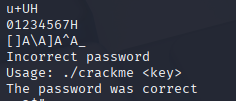
Checking the imports in Ghidra shows only a few basic functions:
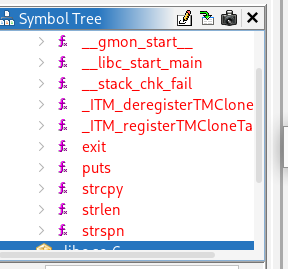
Disassembly Notes
Disassembly of this binary in Ghidra was straightforward. No antidebugging or anti-reversing techniques were present.
After printing a usage string, the program checks if the user input is between 5 and 254 characters:

It then verifies that all input characters are digits using strspn:

After this validation, two key functions handle the logic behind validating the input, check_id_xor, and check_id_sum. Note that the binary copies the user’s input to &PASS:

check_id_xor
This function subtracts 48 from both the total input and the last digit, then XORs them:
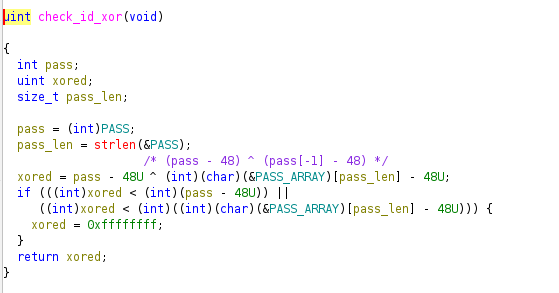
check_id_sum
This function iterates through each character in the input, converts it to a number, and sums them. It expects this sum to equal the result of the XOR function:
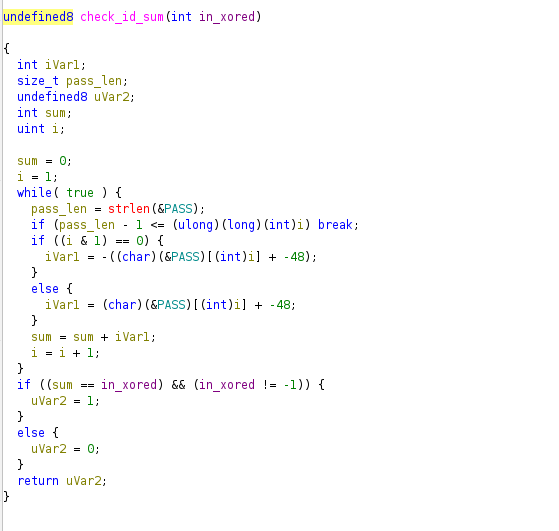
First Attempt: Incorrect Assumptions
With the initial understanding, I wrote a brute-force script that performed the same operations as the binary and stopped once it found a match (xored == sum):
a = 0
while True:
inp = str(a)
# Ensure the length is at least 4
while len(inp) < 5:
inp = "0" + inp
# Convert to integer and list of numbers
inp_int = int(inp)
inp_list = []
for i in inp:
inp_list.append(int(i))
# XOR
xored = (inp_int - 48) ^ (inp_list[-1] - 48)
# SUM
s = 0
for i in range(len(inp_list)):
x = 0
if i == 0:
x = -(inp_list[i] - 48)
else:
x = inp_list[i] - 48
s += x
print(xored, s)
if xored == s:
print("FOUND ", inp)
break
else:
a += 1
This yielded 00213, but the binary rejected it:


Deeper Dive with IDA
Opening the binary in IDA made the real logic clearer.
Only the first and last digits are XORed (not the entire number!):
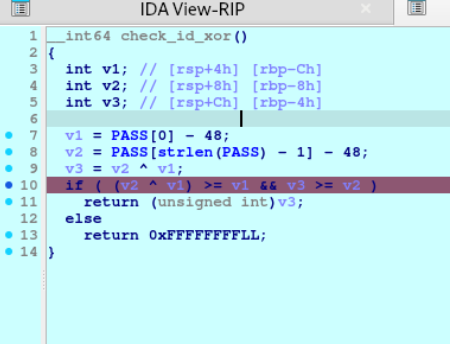
Sum logic is dependent on index parity:
- Subtract on even indices
- Add on odd indices
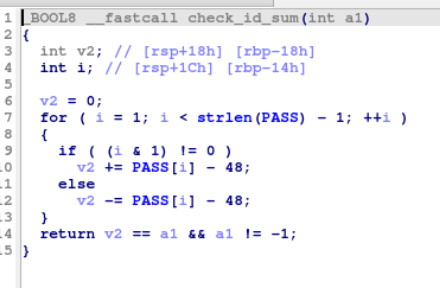
Finally, The -48 operation is just converting ASCII to integers ('0' = 48).
Fixed Cracker
With the correct understanding, I rewrote the script:
def check_id_xor(inp_list):
a = inp_list[0]
b = inp_list[-1]
xored = b ^ a
bad_num = True
if (b ^ a) >= a and xored >= b:
bad_num = False
return xored, bad_num
def check_id_sum(inp_list):
s = 0
for i in range(len(inp_list)):
if i & 1 == 0: # Even
s -= inp_list[i]
else:
s += inp_list[i]
return s
a = 0
while True:
inp = str(a)
while len(inp) < 5:
inp = "0" + inp
inp_int = int(inp)
inp_list = []
for i in inp:
inp_list.append(int(i))
xored, bad_num = check_id_xor(inp_list)
if bad_num:
a+=1
continue
s = check_id_sum(inp_list)
print(xored, s)
if xored == s:
print("FOUND ", inp)
break
else:
a += 1
Running this yields the correct solution: 00000
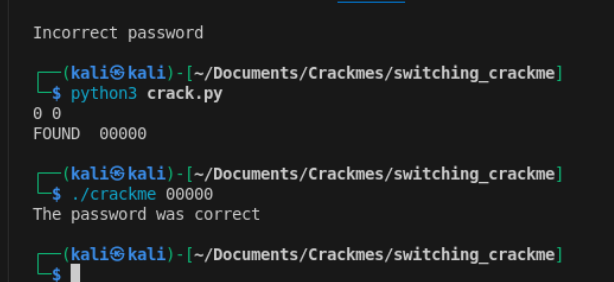
Conclusion
This was a fun, simple challenge with a straightforward key-gen solution. My initial mistakes came from assuming too much about how the XOR was calculated. A quick look in IDA helped clarify the logic and fix the brute-force script.
This serves as a great example of how taking time to reanalyze assumptions — and verifying details like which bytes are being operated on — can make or break your reverse engineering process.
Enjoy Reading This Article?
Here are some more articles you might like to read next: